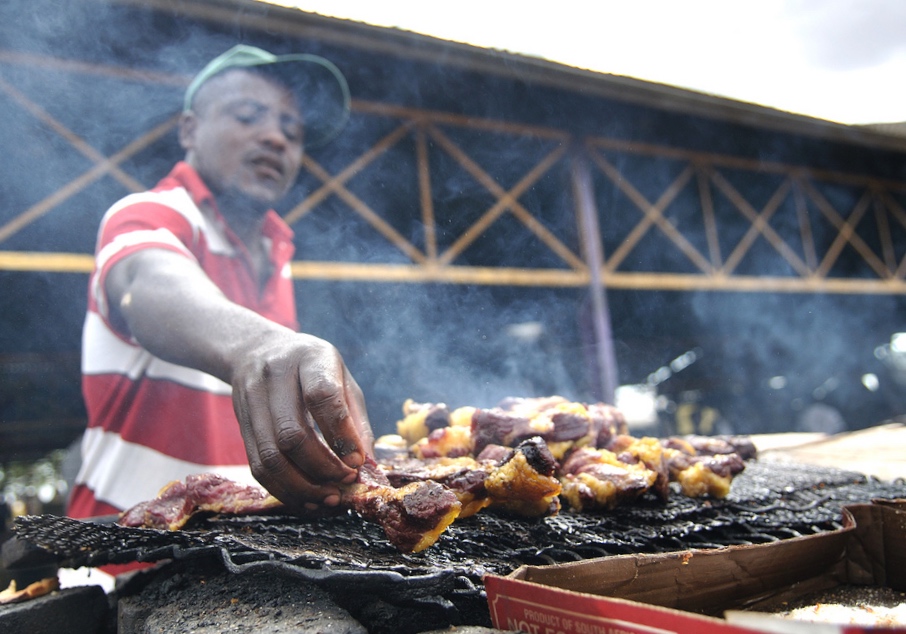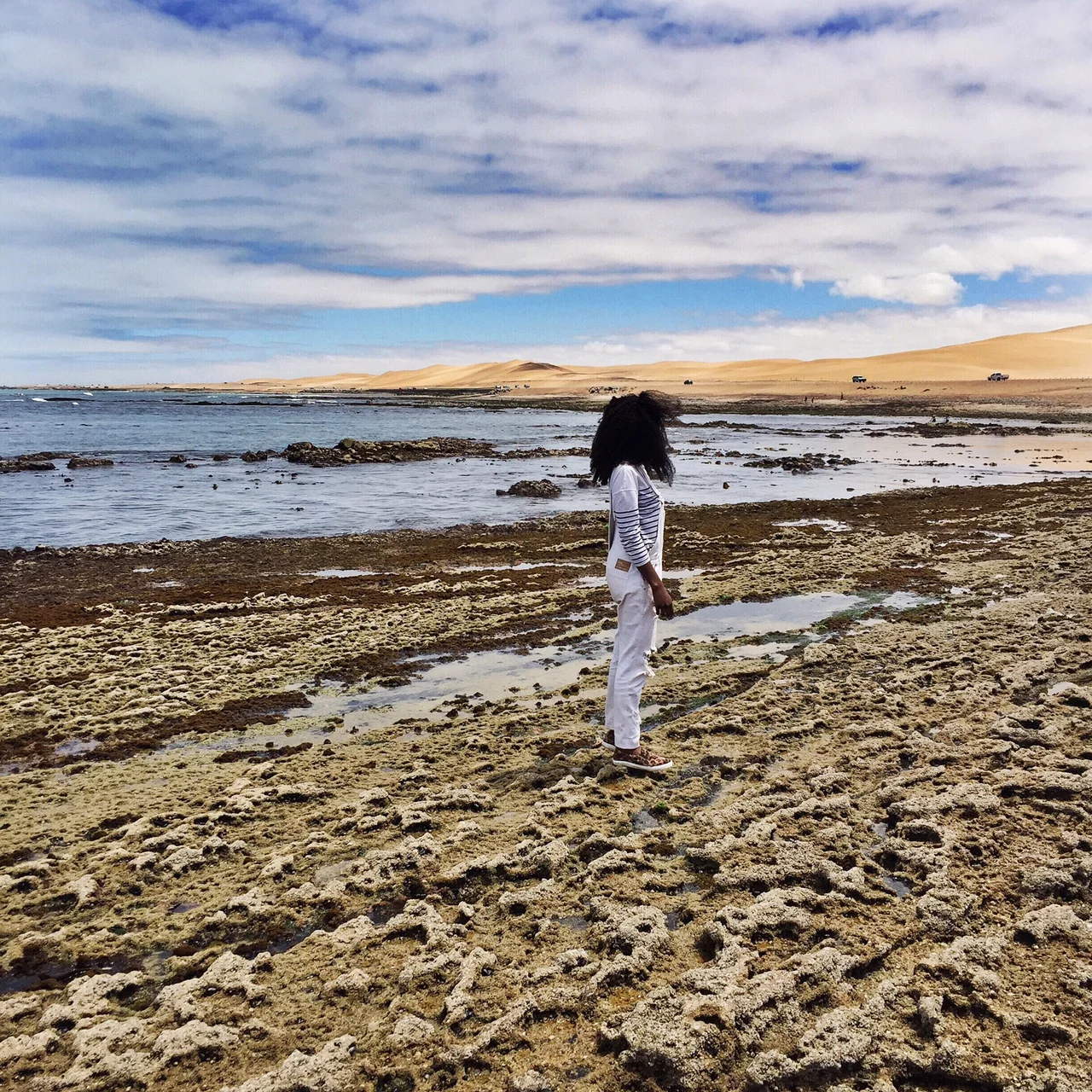Though adventuring through each surreal and wide-open landscape left a lasting impression on me, I'd be remiss not to note that it was Thomas Mpande - my driver/friend/guide extraordinaire - who was the vessel that truly enriched my entire experience. Fluent in six languages (English, Portuguese, Afrikaans, Gangela, Rukwangali, and Oshiwambo), Thomas was incredibly sharp and had in-depth knowledge of all things Namibia. His great sense of humor also made him a fun travel companion, especially as we navigated the best parts of Namibia together: its culture.
When we first met, I expressed my genuine interest to expose myself to his version of Namibia, not just the one sold to visitors. Where does he shop? What does he eat? How/where does he spend his free time? I wanted to see it all. I was also very intrigued by both the Himba and Herero tribes and had high hopes to gain more insight into their history, culture, and lifestyle. Since I had a very limited amount of time (realistically, there's only so much one can do/see/experience in ten days), Thomas encouraged me to focus on delving deeper into the neighborhoods within Windhoek as opposed to other regions we explored; where I would end up getting much more than I could have hoped for.








Katutura Township
First up was Katutura, my favorite place in Windhoek, whose name translates to “a place where people don’t want to live” in the local Otjiherero language. The township (that I had been vehemently warned against visiting) was originally created during the apartheid regime in 1961 when roughly 7,000 black Namibians were forced to give up land they owned and move into the isolated settlement (see what I did there? Happy Black History Month!). Though no longer oppressed, the neighborhood is still home to two thirds of the city’s population, with most individuals living in overpopulated metal sheds.
Driving down Eveline Street (also known as “the street that never sleeps”) we explored the colorful shops, lively bars, and hair salons filled with patrons. In Single Quarters, I happened upon a thriving meat market where most locals go to eat Kapana, a grilled beef served with a chili pepper sauce, indulge in Mopane, dried protein rich caterpillars known locally as a delicacy, and just socialize and mingle with one another. Despite its charm, I would recommend you bring an open mind if you decide to visit - especially if you don't eat meat because you'll see butchers hard at work. As Thomas and I stood next to a particularly crowded and lively grill, I spotted some Herero women crossing the street dressed in their traditional brightly colored voluminous Victorian style dresses and uniquely shaped hats. After sprinting after them (I know, borderline creepy), they seemed flattered at my interest in their culture and were kind enough to answer some of my questions.The most striking part of my entire experience in Katutura was trading stories with new friends and exchanging positive energy; especially in an area generally dismissed by most people.
Other notable gems in Windhoek:
Parliament Gardens - A great place for a quiet picnic with friends or family. We didn't spend too much time here, but strolling through the beautifully manicured oasis as we watched some kids play football (soccer) nearby was a welcome change of pace to the chaotic beauty that was Single Quarters in Katutura.
Goreangab Dam - A good place for an afternoon party, Goreangab was my second favorite place in Windhoek. Filled with groups of people from Katutura, the entire lot was a scene from what you'd expect from any lively barbecue. After being invited to hangout with some friendly (and way too flirty) guys, Thomas and I joined in the festivities; gathering around their picnic table to have drinks and enjoy some electrifying African tunes (Skelewu and Kukere were obviously crowd favorites) that blasted from their nearby car. Good dancing, great company, and an incredible time was had by all.
Olympia Swimming Pool - Another thrilling place to have fun, Thomas and I spent several hours relaxing at this popular public pool. For only N$6 each (roughly 50 cents), we had all day passes to swim in any one of the two Olympic sized pools. Most of our time there was spent watching some young boys playfully battle amongst themselves, hoping to out-dive one another.
Other notable places outside of Windhoek (and the Namib Dunes & Deadvlei) Thomas recommended were:
Swakopmund City/Skeleton Coast/Walvis Bay - It was life-changing to witness the rare sight of a sea of desert dunes colliding against powerful waves of the ocean within one single landscape. There were also a host of activities available to do in the area like sand-boarding, sky-diving, quad-biking, or camel riding. You could also decide to simply take in the city life and lively beaches in Swakopmund City, or admire the large flocks of flamingos as they roam on the coast in Walvis Bay.
Etosha National Park - I wasn't able to visit the park for myself due to time constraints and its far north distance, the game reserve would certainly be worthwhile if you can make manage it. A wildlife utopia, the park is home to hundreds of varying species of mammals, including the black-faced impala as well as several threatened and endangered species like black and white hippos.
Kolmanskop – A major attraction for photographers (and another destination I wish I had time to visit myself), Kolmanskop is an abandoned town originally built by the Germans in colonial times, whose buildings are now completely consumed by surrounding desert sand.



Overall, my time in Namibia was one unlike any other travel experience I've had (in Africa or otherwise). Nowhere else have I ever been in such a constant state of amazement; consistently being welcomed by so many friendly people, always learning something new, and continuously being stunned by one surreal landscape after the other. It’s pretty dramatic to say, but arriving back in Atlanta after such an incredible adventure felt like the clock had just struck 12, and my glamorous carriage was turned back into a garden pumpkin.
If you're you're planning a trip to Namibia, please consider Thomas for any airport transfer, overland, or guide services. He can be reached by email at thomas.mpande(at)gmail.com or phone +264 81 307 6924. Tell him Lee sent you :)
Did this story help you?
If you enjoyed this piece and would like more content like this, please consider a donation to Spirited Pursuit - we'd be so grateful!














